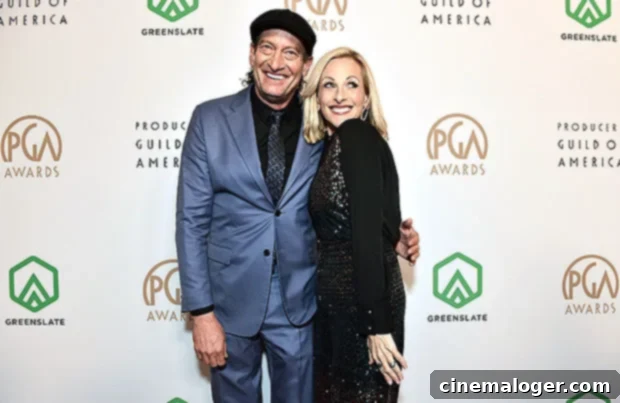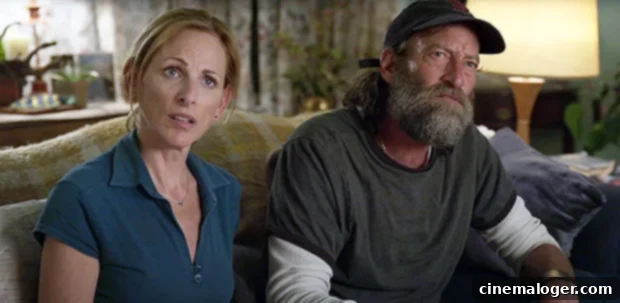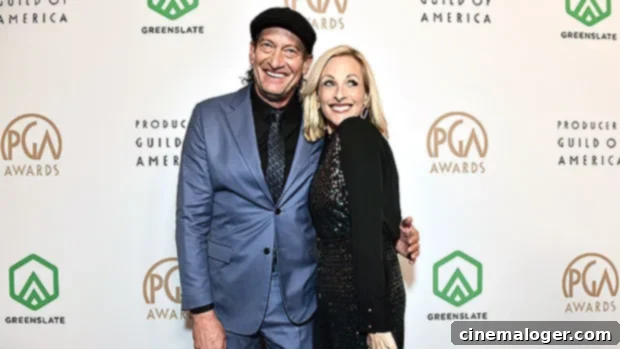Troy Kotsur on Reuniting with Marlee Matlin and Championing Deaf Representation in Hollywood Post-CODA
Following their groundbreaking success with the Academy Award-winning film CODA, deaf Oscar winners Troy Kotsur and Marlee Matlin captivated audiences worldwide with their powerful performances as Frank and Jackie Rossi. Now, Kotsur reveals his profound enthusiasm for a potential reunion with his talented co-star, expressing a genuine desire to collaborate again on future projects. Beyond individual career aspirations, Kotsur is also a passionate advocate for greater deaf representation within the film industry, leveraging CODA’s historic impact as a catalyst for meaningful, lasting change in Hollywood.
A Cherished On-Screen Partnership: Troy Kotsur and Marlee Matlin
The authentic chemistry and deep understanding between Troy Kotsur and Marlee Matlin were undeniable in CODA, earning them both critical acclaim and, ultimately, coveted Academy Awards. Kotsur, who made history by winning the Best Supporting Actor Oscar for his heartfelt portrayal of the patriarch Frank Rossi, shared his genuine admiration for Matlin, who brought the equally compelling character of Jackie Rossi, his wife in the film, to life. “I’d be so honored to work with Marlee again,” Kotsur, 53, told HollywoodLife EXCLUSIVELY. “It’s nice to have two deaf Oscar Award-winners in one picture. Imagine that, why not?” This enthusiastic sentiment was expressed during his appearance at The Hollywood Reporter’s inaugural “Raising Our Voices: Setting Hollywood’s Inclusion Agenda” luncheon on Wednesday, April 20, held at the prestigious Maybourne Beverly Hills Hotel.

Their joint success holds particular significance in the annals of film history. Matlin, 56, initially blazed a trail as the first deaf actor to win an Academy Award for Best Actress in 1987 for her unforgettable performance in Children of a Lesser God. Kotsur’s subsequent win for CODA marked another historic milestone, firmly solidifying their status as pioneering figures and leading advocates for deaf talent in Hollywood. The prospect of these two celebrated artists reuniting on screen sparks exciting possibilities for film enthusiasts, diversity advocates, and the broader entertainment industry alike. Their collaborative dynamic, characterized by a deep personal understanding and shared professional experience, promises to bring even more compelling, nuanced, and authentic narratives to life, further enriching the cinematic landscape.
Creative Pitches for Future Collaborations
When discussing potential future projects, Troy Kotsur offered some wonderfully humorous and imaginative ideas for working with Marlee Matlin again. “You know, we’ve been talking about a few ideas, maybe we can become divorced,” he chuckled, painting a vivid picture. “We can be a separated or divorced couple and have to fight about custody of our kids. Or maybe she could be my bitchy sister. There’s so many great possibilities.” These lighthearted yet thought-provoking suggestions hint at the vast and untapped range of roles and stories that could explore the complexities of human relationships from a deaf perspective, moving gracefully beyond the immediate family dynamic so powerfully portrayed in CODA.
The potential for Kotsur and Matlin to explore entirely new character dynamics—whether as estranged spouses locked in a custody battle or as siblings navigating a complicated, often humorous relationship—opens doors for narratives that defy conventional expectations and stereotypes. Such projects would not only magnificently showcase their incredible acting range and versatility but also continue to normalize the robust presence of deaf characters in mainstream cinema. These roles would allow them to embody universal themes of love, conflict, family, and personal growth, demonstrating that deaf characters can be defined by their full human experience rather than solely by their deafness. Their previous collaboration in CODA, alongside Emilia Jones as their hearing daughter and Daniel Durant as their deaf son, already demonstrated their unparalleled ability to portray a rich, authentic, and deeply moving family unit, leaving audiences eager for more groundbreaking performances.
CODA: A Landmark for Deaf Representation in Hollywood
The success of CODA transcended mere box office numbers and critical acclaim; it marked a truly pivotal and transformative moment for deaf representation in Hollywood and beyond. Troy Kotsur eloquently articulated the film’s profound impact on bridging communities. “I’ve been waiting for Hollywood to be ready and CODA was a beautiful step forward to really bridge two worlds; the deaf world and the hearing world,” he explained with conviction. “There’s always been that gap. There hasn’t been that bridge for so long and with CODA, the child of a deaf adult played by Emilia, she represented hearing culture because she could communicate verbally but also, she could communicate in sign language. CODA pulled these two worlds together and so there’s no gap in our film.”

CODA, an acronym for Child Of Deaf Adults, tells the heartwarming and poignant story of Ruby Rossi, the only hearing member of a deaf family, who discovers an undeniable passion for singing while navigating her family’s struggling fishing business. The film’s authentic and empathetic portrayal of deaf culture, including its extensive and respectful use of American Sign Language (ASL) and its nuanced depiction of the daily challenges and profound joys within a deaf family, resonated deeply with audiences and critics across the globe. Its remarkable journey from a beloved Sundance Film Festival sensation to a history-making Best Picture Oscar winner unequivocally underscores a burgeoning appetite for diverse, inclusive, and genuinely human storytelling in mainstream cinema. It proved that stories centered on marginalized communities can achieve universal appeal and critical success.
Beyond CODA: The Future of Deaf Representation
The trailblazing success of CODA has rightly energized a crucial conversation about the continued and imperative need for authentic deaf representation throughout Hollywood. Troy Kotsur is at the forefront of this vital movement, consistently emphasizing that CODA, while groundbreaking, is merely a powerful first step. “We’ve been waiting for a story like that and so our film has been so impactful as a first step forward and has really influenced folks to gain a new perspective,” Troy continued. “We’re all humans, we only communicate in different languages, that’s all. And so, if you see a deaf person, does that mean they’re limited, or a victim because they can’t hear? Don’t forget, we use our eyes, we can see, we can feel, we have a heart. What you hear is what I can see and we’re all human beings and we’re all here to collaborate and work together.”
Kotsur’s powerful and eloquent words directly challenge common misconceptions and harmful stereotypes surrounding deafness. He advocates passionately for a fundamental shift in perspective, urging both audiences and industry professionals to recognize the full humanity, boundless capabilities, and inherent value of deaf individuals. This expansive vision extends far beyond merely casting deaf actors; it calls for authentic narratives that are meticulously written by, sensitively directed by, and richly centered around deaf experiences, thereby consciously avoiding tokenism or reductive, one-dimensional portrayals. The ultimate goal is to move decisively towards a Hollywood where deaf characters are multifaceted, diverse, and integral to a wide array of stories, accurately reflecting the richness, complexity, and vibrancy of the deaf community itself.
The demand for stories that authentically portray marginalized communities, including the deaf community, is steadily increasing worldwide. Audiences are increasingly seeking content that genuinely reflects the diverse world they live in and the varied human experiences within it. This significant cultural shift represents a substantial opportunity for studios, production companies, and independent filmmakers to wholeheartedly embrace inclusivity not just as a moral imperative but as a powerful creative and commercial advantage. By proactively investing in projects that champion deaf talent and narratives, Hollywood can continue to break down long-standing barriers, fostering a more equitable, representative, and ultimately, more compelling entertainment landscape for everyone.
A New Era of Inclusion: Setting Hollywood’s Agenda
Events such as The Hollywood Reporter’s “Raising Our Voices: Setting Hollywood’s Inclusion Agenda” luncheon, where Troy Kotsur so powerfully spoke, are absolutely crucial in driving these vital conversations forward. These platforms bring together influential industry leaders, visionary creators, and dedicated advocates to discuss concrete, actionable steps towards greater diversity, equity, and inclusion across all facets of the industry. The prominent presence and compelling voice of figures like Kotsur, fresh off his historic Oscar win, significantly amplify the message and provide tangible, inspiring proof of the transformative power of inclusive storytelling.
The dialogue at such impactful events often revolves around practical strategies designed to foster a more accessible and inclusive environment. These include increasing physical accessibility on sets and in post-production facilities, actively investing in deaf writers and directors to ensure authentic storytelling, and ensuring that certified sign language interpreters are readily available at all stages of production. These measures are not just beneficial but vital for fostering an environment where deaf professionals can thrive, contribute their unique talents, and share their invaluable perspectives without facing systemic barriers. Kotsur’s personal journey, from stage acting to independent films and ultimately to mainstream success with CODA, serves as an inspiring example of unwavering perseverance and illustrates the immense potential that lies within the deaf community, eagerly waiting to be fully tapped by the entertainment industry.
His message is clear, resonating with hope and determination: deaf individuals are not defined by what they cannot hear, but rather by their rich cultural identity, their incredible resilience, and their profound ability to connect, collaborate, and contribute meaningfully to the world. By seeing deaf people for their full humanity and embracing their unique perspectives and experiences, Hollywood can unlock a wealth of untold stories and create a more vibrant, authentic, and truly inclusive cinematic future. The fervent hope is that the powerful momentum generated by CODA and the influential voices of pioneers like Troy Kotsur and Marlee Matlin will lead to a sustained, unwavering commitment to deaf representation, ensuring that their impactful work is just the beginning of a long, fruitful, and truly transformative journey toward full inclusion in the global entertainment landscape.
